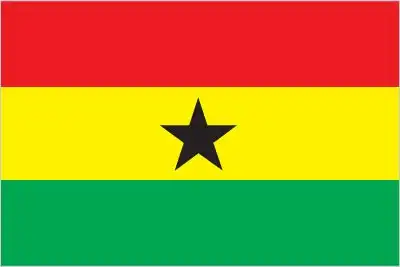Ghana Flag
National Flag of Ghana
Ghana Flag Display

Quick Facts About Ghana and Ghana Flag
- Adopted:
- Aspect Ratio:
- 2:3
- Capital:
- Accra
- Population:
- Approximately 33 million (2023)
Flag Description
The national flag of Ghana is a horizontal tricolour of red, gold, and green, with a prominent black five‑pointed star centered in the gold stripe. This vibrant banner is a powerful emblem of independence, African identity, and pan-African aspirations.
Symbolism & Meaning of the Ghana Flag
Red honors the blood of those who sacrificed in the struggle for independence, gold represents Ghana’s rich mineral wealth—particularly its gold reserves—and green symbolizes the nation’s lush forests and agricultural abundance. The solitary black star stands for African emancipation and unity, popularly associated with the Black Star Line begun by Marcus Garvey and adopted by Ghana’s first post‑colonial government.
Historical Background of the Ghana Flag
Designed under the leadership of Kwame Nkrumah as the country prepared for independence, Ghana’s flag was officially adopted on 6 March 1957, making it one of Africa’s earliest national banners. The colours reflected the ideals of the Pan‑African movement and the prominence of Ghana as a pioneer of African liberation. The flag has remained unchanged since independence and has inspired many other African nations in designing flags featuring similar colours.
Design Elements of the Ghana Flag
The flag consists of three equal horizontal bands—red on top, gold in the middle (bearing the black star), and green at the bottom—in a 2:3 ratio. The bold black star is placed centrally within the gold band. The design is clean and striking, maximizing both symbolism and visibility while maintaining visual simplicity.
Usage & Protocol of the Ghana Flag
Ghana’s flag is flown on public buildings, private homes, schools, and official events. It is hoisted at sunrise and lowered at sunset, never touching the ground or appearing in damaged form. In times of national mourning, such as independence anniversaries or the death of a sitting president, the flag is flown at half‑mast as a mark of respect. Special flag days—such as Independence Day and Republic Day—are observed nationwide with ceremonies and flag‑raising exercises.
Frequently Asked Questions
What do the colors of the Ghana Flag represent?
Red honors the blood of those who sacrificed in the struggle for independence, gold represents Ghana’s rich mineral wealth—particularly its gold reserves—and green symbolizes the nation’s lush forests and agricultural abundance. The solitary black star stands for African emancipation and unity, popularly associated with the Black Star Line begun by Marcus Garvey and adopted by Ghana’s first post‑colonial government.
When was the Ghana Flag adopted?
The Ghana flag was adopted on 6 March 1957, marking an important milestone in the country's development as an independent nation.
What is the aspect ratio of the Ghana Flag?
The Ghana flag has an aspect ratio of 2:3, which determines the proportional relationship between its width and height for official display purposes.